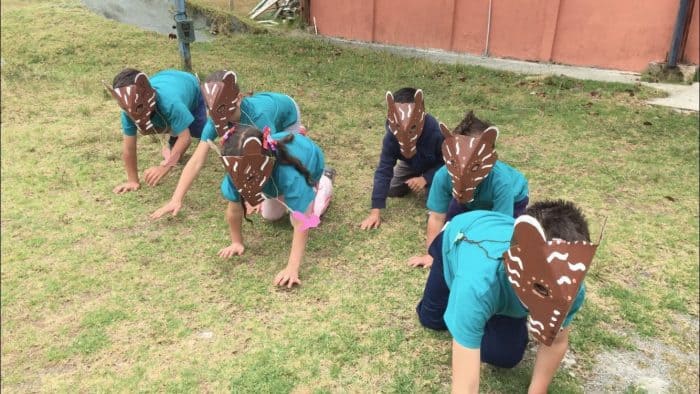The Central American tapir is large. In fact, it’s the largest terrestrial mammal in the Neotropics. These animals can weigh up to 300 kilograms and the Bribri people of Costa Rica believe that a giant tapir created the Earth.
While they’re large, they are also 100 percent herbivorous.
They have long trunks that help them grab fruits and leaves. Despite these trunks, dantas are part of the perissodactyl group and their closest relatives are rhinoceroses and horses, not elephants.
Interesting facts, right?
Unfortunately, these impressive animals are also endangered species. However, not all is lost, a conservation project called Nai Conservation seeks to shed some light on this issue. The name derives from the Bribri word for tapir: Nai.
Nai Conservation
The project has gathered young professionals from diverse disciplines with a common goal: Saving dantas.
Here are some of the minds behind Nai Conservation’s initiative:
Esteban Brenes, biologist and Nai Conservation’s project leader; Jorge Delgado, publicist, graphic designer and Nai Conservation’s co-founder; Nicole Leroy-Bealieu, preschool education student; Cristina Aguilar, forest manager; Patricia Blanco graphic designer and plastic artist; Jorge Rojas, veterinarian; Mauricio Sanabria, social communicator and audiovisual producer; Juan Carlos Delgado, geneticist; Nick Hawkins, photographer and Lucía M. Cole, anthropologist.

“The danta has always been my favorite animal,” said Brenes.
“Nai conservation’s mission strives to preserve the dantas’ habitat in Costa Rica while promoting a concordant coexistence between community inhabitants and tapirs,” said Brenes.
Brenes said that the dantas’ habitat had been historically destroyed. He also said that just in the past 30 years as much as a 70 percent of their territory, which spans from Mexico to Colombia, has been severely devastated.
He said that poaching, which often centers around their meat and leather could be a factor, too. However, he stated that over the past years it had also been triggered by disputes between farmers.
Also, he said that here in Costa Rica and Belize tapirs had been threatened by road accidents.
Gardeners of the Forest
Tapirs are known to walk long distances, it’s why they’ve earned the title “Gardeners of the Forest.” Their active bowels also helped them earn that title.
“Since they are large animals and need to feed themselves properly, they can eat up to 35 kilograms of vegetation,” said Brenes. “They eat seeds, leaves, fruits, tree barks. Tapirs can swallow seeds up to 6 centimeters, walk long distances, and defecate them along their path, dispersing seeds throughout the forests, seeds that will become trees in the future. This cycle significantly contributes to the forest stability.”

Brenes also said that according to several studies, tapirs are known as gardeners of the forest, because they were among the leading allies to mitigate climate change.
“They have the capacity to disperse big fruits which would turn into big trees which tend to absorb most carbon dioxide,” said Brenes.
Nai Conservation’s work
That’s why Nai Conservation considers their work to be of utmost importance.
The conservation project was born in 2015, when Brenes was financially supported by the Zoological Society of London (ZSL), a nonprofit organization dedicated to the conservation of animals worldwide.
Then, he began a research project with tapirs.
Brenes said that Jorge Delgado got involved in Nai Conservation next. Delgado told him that it would be great to transcend from scientific researching to a more visible and integral endeavor.

Esteban said that the project increasingly gained steam and drew the attention of young professionals, who saw Nai Conservation as a platform for their research projects and a place to contribute to conservation from their academic fields.
“We formed a collective, we believe in a coexistence concept,” said Brenes
Educating through Salva-Dantas
Nai Conservation efforts focus on research and education through Salva-Dantas, which is Nai Conservation’s education and outreach program.
Nicole Leroy-Beaulieu is studying to be a preschool teacher and has taken on a major role in Salva-Dantas.
“This is an initiative aimed at children, we want them to feel responsible for tapir’s conservation,” said Leroy-Beaulieu. “Our education principle is based on constructivism, a learning theory that suggests how children or people can acquire knowledge from their experiences.”
Nicole said that their initiative was inspired by tapir babies, commonly known as watermelon babies.

“Tapir babies are known as watermelon babies, because of their stripes on their fur, which make them look like a watermelon, however, they lose these after a year,” said Brenes.
Nicole said that the methodology applied allowed children to experience the danta’s environment.
“They wear watermelon babies’ masks, cross a river, eat seeds, go through a chamber to learn more about tapirs, then a simple and small talk is imparted to them,” said Leroy-Beaulieu. “This in order to make them understand dantas.”
“Then upon completion of the program, they are given their certificates which states they have become “Salva Dantas.”
“It is important to stress that most of these children live in communities that are also inhabited by dantas.” Brenes added.
Awarding conservation

Esteban Brenes was awarded with the “MAB young scientist,” award from the United Nations Educational, Scientific and Cultural Organization (UNESCO).
The award recognizes the work of young people around the world and their fight to preserve the planet.
This is the first time a Costa Rican won the award. After three years of researching and efforts aimed to preserve the danta’s habitat, Brenes and his team say every attempt pays off.
You can go to naiconservation.org or visit Nai Conservation’s Facebook page, for more information.






